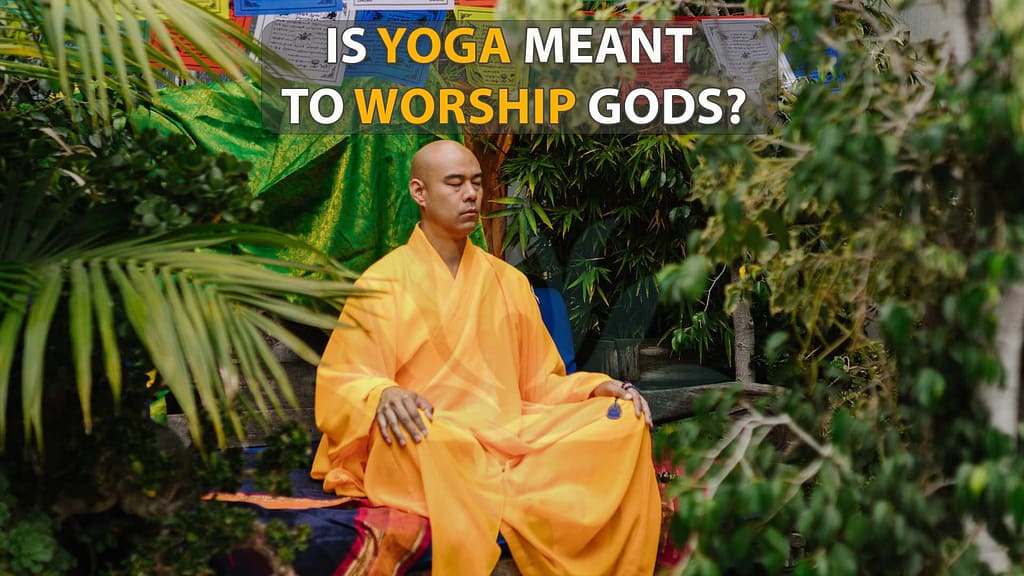Is Yoga Meant To Worship Gods? – Why Yoga consider is hinduism In 2024

Is Yoga Meant To Worship Gods?
When the names of yoga poses are separated from the movements, many of these poses may be found in workout routines. This is true even if some yoga lineages adopt the custom of worshiping various gods with yoga postures and some pose names may sound like names of idols.
No, it’s not like that, as yoga isn’t a religion, even though it bears some resemblance to Buddhism and Hinduism.
Even though modern yoga uses Sanskrit terminology or the prayer mudra, simply engaging in yoga poses does not automatically equate to indulging in genuine devotion. Yoga’s technological foundation and spiritual practice are older than all religions.
Continue reading to discover the origins of these misconceptions and why yoga is frequently misunderstood as a devotion.
Yoga as a technique
Yoga is free of all religions. Your ability to utilize yogic methods is independent of your religious affiliation.
Yoga is a technique, hence. it is irrelevant to technology for what you hold important, whatever else. It has nothing to do with using technology; whether you believe something or not is just a psychological process.
When we say that yoga Are worshiping gods specifically Hindu or Buddhist, just because a Hindu or Buddhist guru introduced it? Does the fact that Isaac Newton, who lived in a Christian society, developed the law of gravity make gravity Christian?
Everyone willing to use it can do so. It is ridiculous to even consider that yoga may have a religious undertone.
Read:
Is Meditation A Form Of Worship? – Difference Between Worship And Meditation In 2023
Does yoga believe in God?
Even though they believe in a maker of the universe (called Ishvara), most Hindu and Vedantic yoga practices emphasize self-realization more than worshiping God. So, Yoga isn’t a set of beliefs.
But at the same time, Asanas and meditation are both parts of the Yogic experience as a whole, but Yoga itself means something very different. “Yuj” is the Sanskrit word for “union,” and “union with God” is what “Yuj” means.
It is being able to separate yourself from the world and connect with God. It means getting closer to God.
What does yoga say about God?
Yoga says that God is a special Purusha, or supreme soul, that has never been, is not now, and will never be influenced by suffering, the things that cause suffering, karma, or the results of karma.
Gods that are Worshiped in yoga
Mostly Hindu yogis worship their gods in yoga. Their names are as below:
- Vishnu ( The god of safety)
- Shiva (The god of both defense and destruction)
- Brahma (God who made everything)
- Trimurti means “three gods.” (Trimurti means “having three forms,” and it is used to discuss the three main Hindu gods: Brahma, Vishnu, and Shiva.)
- Kali (Mother Kali is the goddess of death, time, and the end of the world. She is strong and often mistaken.)
- Lakshmi (For Hindus, the goddess Lakshmi is the personification of beauty, grace, wealth, fertility, cleanliness, and kindness.)
- Saraswati (Saraswati, the goddess of knowledge and art, symbolizes how understanding and awareness can move freely. )
- Ganesha (the master of success and the one who gets rid of all problems. )
- Hanuman (The powerful god, who looks like a monkey, is the best example of faith and dedication.)
Why Yoga Is Mistaken For Worship?

It makes sense that many people (particularly in the West) believe yoga lessons with Sanskrit phrases or short chanting have a religious component. Several facts support such a statement.
1- Yoga chants
Yoga has different chants before and after class. The most frequent chant used to begin a yoga session is the mantra “Om.” Om is adored in the Hindu religion and is called the universal sound.
Yoga does not require worshiping gods, even if it involves a prayer or chant. However, it is used to aid in mental relaxation and increase concentration on your practice-related goal.
2- Sanskrit words
India’s classical and historical language is called Sanskrit. Sanskrit is the ancestor of numerous Indian languages, including Hindi, though it has nothing specifically to do with Hinduism.
Regarding terminology, pronunciation, and writing, Sanskrit and Hindi share certain similarities but have many differences.
Sanskrit is utilized in yoga sessions to maintain the practice’s connection to its ancient Indian origins. Some Sanskrit phrases have a strong vibration that might affect your spirit. “Om Shanti, Shanti, Shanti” is a well-known Sanskrit Ashtanga mantra to end a yoga lesson.
3- Yoga poses that looks like offerings to Hindu gods

Several yoga positions, like Urdhva Hastasana (upward hand posture), Utkatasana (chair pose), and Vrikshasana (tree pose), can also require uniting your palms and lifting them upward, which could be seen as worship.
Even so, asanas that resemble prayer postures might be done to show respect for the age-old tradition. This concentrates the mind or works on a certain body area.
Read:
Is Yoga Considered A Type Of Hindu Ritual? – Separating Myth From Reality 2023
A few yoga poses are named after Hindu Gods
There are up to 169 asanas that are practiced and known throughout the many distinct yoga systems. Just a small number of these poses worship gods, however, correspond to Hindu deities.
The titles of various yoga pose frequently refer to lords, warriors, things, or creatures. It’s important to understand that while certain postures have God’s names, most don’t.
Here are some yoga poses worship of gods:
1. Surya Namaskar
In Sanskrit, Surya Namaskar means “to salute the sun.” Sun salutations were a morning practice in ancient Indian culture to worship the sun.
The Vedas portray the sun as a strong, all-seeing god who keeps track of good and bad deeds. Sun salutations are common for modern yogis to show thanks to the sun and mother earth since they give us vital life energy.
2. Bhairavasana
It is a reverse plank pose with one leg behind the head. You must have extraordinary strength and hip flexibility. Bhairava is a symbol of Shiva, the Hindu deity of destruction.
It might seem like an awkward posture, as the leg is cutting off the head in this. This relates to a Shiva-related Hindu story, and adopting this pose reminds one to keep one’s ego in check.
3. Hanumanasana
According to tales in Hindi, Hanuman jumped between trees in the forest by swinging one leg forward and the other backwards. It is similar to the split posture. Notably, this position was one of the more recent asanas to be introduced into yoga practice in the 20th century.
4. Natarajasana
Shiva is greatly respected as the God who characterizes the universe’ dynamic movement. Although Natarajasana was not designed for Shiva worship, Natarajasana, often known as “dancer’s posture,” calls for keeping both your inner and outer harmony
. You must maintain mental calmness as your body and the outside world constantly shifts in the challenging balancing posture.
5. Virabhadrasana
Virabhadra was the son of Lord Shiva. A fierce warrior who was always positioned and prepared for battle. The purpose of Virabhadrasana was not to worship Virabhadra or any other deity. Instead, because of how close it is to various positions in the gymnastics of Niels Bukh, its name was inspired by European gymnastics.
6. Astavakrasana
It was used in hatha yoga in the 20th century, when it first appeared in the book Light on Yoga, like other postures named for gods. Nonetheless, it does exist in the 1896 Vyayama Dipika gymnastics guide, suggesting that this exercise served as a model for the advanced hand-balancing asana.
Yoga can begin with a small prayer
(Calling Patanjali to mind at the beginning of a yoga class) I honour the wise man Patanjali, who gave us yoga (yoga) to clean the mind, words, and speech (citta, pada, and Vacca). Patanjali gave us the medicine (vaidyakena) to get rid of the dirt (malam) in the body (shararas).
Some yoga postures involve the prayer position
- Mountain Pose Namaste.
- Tadasana Namaskarasana.
- The Prayer Pose.
- Pranamasana.
- Tadasana Namaste.
- Standing Hands to Prayer (Heart Center)
- Standing Prayer Pose.
History of Yoga Postures

Yoga positions first developed in the year 2700 B.C., before Hinduism. The earliest yogic literature mentions no god-related yoga positions, like the Vedas.
Interestingly, a few yoga texts started referring to particular asanas as names of deities in the early 20th century (not even gods).
How is it that some positions are named after gods if practising yoga does not include worshipping them? Because of how they seemed, how they acted, or what they stood for.
When we name a posture after a god who possesses qualities, we can practice it to replicate their qualities, such as strength and selflessness.
Some say yoga existed before all religions. In comparison to religion, yoga is a practical, scientific, and practical method.
It is built on the most basic understanding of the nature of the universe and our place in it, not on mythology or fairy tales. Worshipping gods with the faith that reality is what it is is foolish and risky.
Yoga promotes seeking the truth rather than accepting it as fact. Blind belief is a mental illness that has trapped millions of people in the depths of ignorance. Yoga promotes searching and criticism.
It provides not pre-made, crafted solutions but a possible route for discovering the truth. Yoga is for those with the guts to challenge and reject the most fundamental truths we hold about the world.
It is for the wise, not the person who mistakenly believes that only worshipping gods are the only source of salvation.
Read:
Is Yoga A Sin, Yes Or No? According To Christianity 2023
Final Remarks
It is understandable why some believe yoga is a religion or God worship. Yoga is not a religious activity, even though some aspects have a divine quality. While you utilize the postures to concentrate on developing your health and wellness, the only person you worship via yoga is yourself.
FAQs: are yoga poses worship?
Q: Should Christians Do Yoga?
Yoga and Christianity aren’t in conflict with each other, but they do need to be dealt with carefully. Yoga is similar to Christianity in that it can be seen as a theory and way of life with routines that help build self-confidence, awareness, and inner peace.
Q: Can Muslims do yoga?
A Muslim can do yoga if they do it on purpose for its health and physical benefits and it doesn’t involve any religious routines that aren’t already required by Islam. They can do this while still following their Islamic faith and practices.
Q: Are Hindu Gods Worshiped During Satsangs?
So, in Hinduism, Jainism, Buddhism, and Sikhism, satsang usually means spiritual and religious actions that people do on their own, like meditating or singing. Satsang could also involve reading or listening to spiritual lessons, thinking about what they mean and putting them into practice in everyday life.
Q: Are Sun Salutations An Act Of Worship?
In Vedic times yogis use mantras to greet and praise the morning sun. This is where the Sun Salutations of modern yoga come from.
Q: is yoga worshipping hindu gods?
No, yoga is not inherently about worshipping Hindu gods. It is primarily a physical, mental, and spiritual practice focused on personal well-being and self-improvement.
While some forms of yoga may incorporate Hindu spiritual elements, many people practice yoga purely for its physical and mental health benefits, without any religious connotations.
Video Guide
Read Also
- Is Yoga Considered A Type Of Hindu Ritual? – Separating Myth From Reality 2023
- Can Yoga Cause Chest Pain? – And How To Avoid It In 2023
- Why Do I Feel High After Yoga? Causes In 2023
- Can I Do Hot Yoga After A Tattoo? – Everything You Need To Know In 2023
- Should I Do Yoga Before Or After Walking? – What’s The Best Approach? 2023
- What Is Panchkoti Yoga? – Panch Mahapurush Yoga Impact On Your Life In 2023






